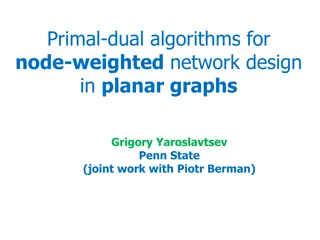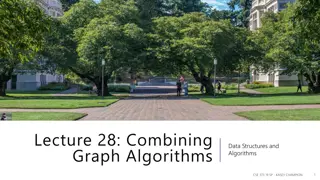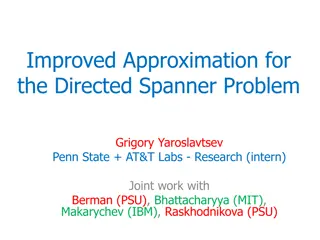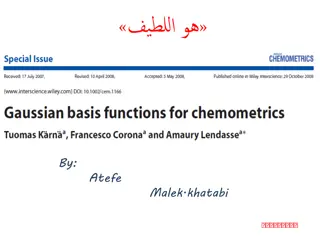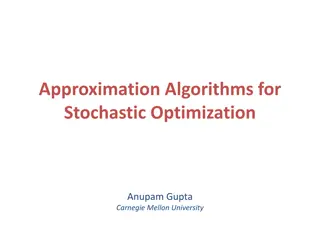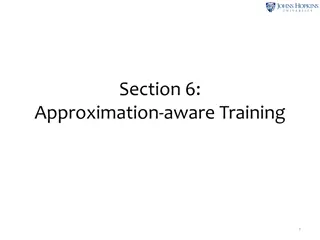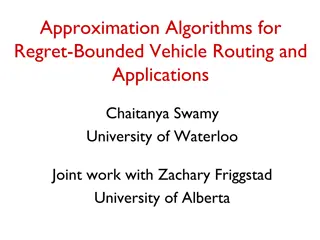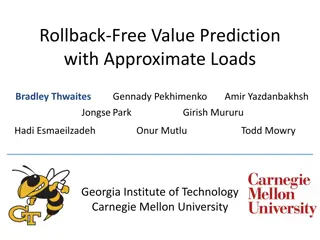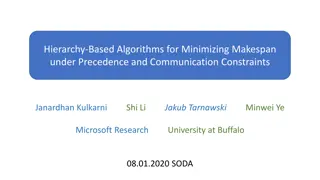Approximation Algorithms in Design & Analysis of Algorithms
Uncover the world of approximation algorithms in the realm of Design & Analysis of Algorithms. Delve into topics like 7/8 approximation for Max-3-SAT, Quick Sort with random pivot, and the 7/8 approximation for Max-3-CNF with in-depth explanations and proofs of the algorithms involved.
Download Presentation

Please find below an Image/Link to download the presentation.
The content on the website is provided AS IS for your information and personal use only. It may not be sold, licensed, or shared on other websites without obtaining consent from the author.If you encounter any issues during the download, it is possible that the publisher has removed the file from their server.
You are allowed to download the files provided on this website for personal or commercial use, subject to the condition that they are used lawfully. All files are the property of their respective owners.
The content on the website is provided AS IS for your information and personal use only. It may not be sold, licensed, or shared on other websites without obtaining consent from the author.
E N D
Presentation Transcript
CMPT 405/705 Design & Analysis of Algorithms March 16, 2022
Plan for today More approximation algorithms 7/8 approximation for Max-3-SAT Quick Sort with random pivot
7/8 approximation for Max-3-CNF Let ? be a 3-CNF formula, i.e., the formula of the form (x1v x2v ~x3) (~x2v x3v ~x4) (~x1v x2v ~x5) Claim: If ? is a 3-CNF formula with m clauses, then there exists an assignment to x that satisfies at least 7m/8 clauses. Proof: Choose each xi to be 0 or 1 independently w.p. each. Let Zi {0,1} be the indicator that the i th clause is satisfied. Then E[Zi] = Pr[Zi= 1] = 7/8 (because 7 out of 8 assignments are satisfying) The expected number of satisfied clauses is E[Z1+Z2+ +Zm] = E[Z1]+ E[Z2]+ E[Zm] = 7m/8. Therefore, there exists an assignment that satisfies at least 7m/8 clauses.
7/8 approximation for Max-3-CNF Write a polynomial time algorithm for the following problem Input: A 3-CNF formula ? with n variables and m clauses. Goal : Find and assignment that satisfies at least 7m/8 clauses. Algorithm (randomized): Repeat T=m*ln(m) times 1. Choose each xi to be 0 or 1 independently w.p. each. 2. Count the number of clauses satisfied by this x. 3. If the number of satisfied clauses is 7m/8, return this assignment If reached here, return FAIL
7/8 approximation for Max-3-CNF Algorithm (randomized): Repeat T=m*ln(m) times: 1. Choose each xi to be 0 or 1 independently w.p. each. 2. Count the number of clauses satisfied by this x. 3. If the number of satisfied clauses is 7m/8, return this assignment. If reached here, return FAIL Claim: Suppose m is divisible by 8. Then in each iteration Pr[number of satisfied clauses 7m/8] 8/(m+8) > 1/m (for m 2) Hence, if we repeat T=m*ln(m) times, then ? ? ln ? 1 ? 1 ? ? ln ?= 1/?. Pr ??? ?????????? ???? 1 = 1
7/8 approximation for Max-3-CNF Claim: Suppose m is divisible by 8. Then in each iteration Pr[number of satisfied clauses 7m/8] 8/(m+8)>1/m. Proof: Let Zi {0,1} be the indicator that the i th clause is satisfied. Then E[Zi] = Pr[Zi= 1] = 7/8 Let X = Z1+Z2+ +Zmbe the number of satisfied clauses. Then E[X] = E[Z1+Z2+ +Zm] = 7m/8. Let Y = m-X. Then E[Y] = m/8 Then, by Markov s inequality, we have ? 8 Pr[? <7? 8] = Pr ? ? ?[?] ? 8+ 1 ? 8+ 1 = = ? + 8. ? 8+ 1
7/8 approximation for Max-3-CNF Algorithm (randomized): A stronger claim: If ? is a 3-CNF formula with m clauses, then Pr[a random assignment satisfies at least 7m/8 clauses] > 0.1. Repeat T=10m times: Choose each xi to be 0 or 1 independently w.p. each. In particular, it suffices to repeat the randomized algorithm only O(1) times for 0.99 success probability. 1. 2. Count the number of satisfied clauses by this x 3. If the number of satisfied clauses is m/8, return this assignment But I don t know an elementary proof of this fact. If reached here, return FAIL What about a deterministic algorithm? Claim: Suppose m is divisible by 8. Then in each iteration Pr[number of satisfied clauses 7m/8] 8/(m+8)>1/m (for m>2) If we repeat T = 10m times, then ?=10? Pr ????? ?? ?????????? ?????????? 7? 1 ? > 1 ? 10. 8??????? 1 1
Quick Sort Given an array A[0 n-1] Choose an element in the array, call it the pivot. Rearrange the elements in the array so that: All A[i] < pivot are to the left of pivot. All A[i] >= pivot are to the right of pivot. Recursively sort to the left of the pivot. Recursively sort to the right of the pivot.
Quick Sort Example: Input: [4, 1, 8, 7, 10, 3] 1. Let pivot =7 2. Rearrange to get [4,1,3] and [10, 8] 3. Sort [4, 1, 3] [1, 3, 4] 4. Sort [10, 8] [8, 10] The steps are: - Choose a pivot - Compare all numbers in A to the pivot, and move them if needed - Run recursion
Quick Sort Running time O(n log(n)) for good pivots Q: What is a good pivot? A:The one that splits the array into equal halves, or n/3 ---- 2n/3 For example: if we split n/5 ---- 4n/5, we get T(n) = O(n) + T(n/5) + T(4n/5) Choose pivot / Rearrange Recursion We saw that the running time is T(n) = O(n log(n)) Q: how can we find a good pivot?
Quick Sort Q: how can we find a good pivot? A: random pivot works Given an array A[0 n-1] Choose a random index i [0 n-1 uniformly set pivot=A[i]. Rearrange the elements in the array so that: All A[i] < pivot are to the left of pivot. All A[i] pivot are to the right of pivot. Recursively sort to the left of the pivot. Recursively sort to the right of the pivot.
Quick Sort Theorem: Quicksort with a random pivot has E[running time]=O(n log(n)). Proof: Idea: Linearity of expectation We get the array A[0 n-1] Think of the sorted array, and call it B = [b0,b1,b2, bn-1]. Let Xi,j = be the indicator that bi and bj are compared during the execution of the algorithm: - Xi,j=1 if they are compared - Xi,j=0 otherwise Observation: running time = O(the total number of comparisons) = O( 0 i<j n-1 Xi,j) ? ??????? ???? = ? ? 0 ?<? ? 1??,? ? 0 ?<? ? 1? ??,? =? 0 ?<? ? 1?? ??,?= 1 Question: how do we compute ?? ??,?= 1 ?
Quick Sort Total running time = O(the total number of comparisons) = O( 0 i<j n-1 Xi,j) ? ??????? ???? = ? ? 0 ?<? ? 1??,? ? 0 ?<? ? 1? ??,? =? 0 ?<? ? 1?? ??,?= 1 Xi,j=1 if and only if bi or bj were chosen to be the pivots before bi+1,bi+1 bj-1. What is the probability of choosing bi or bj to be a pivot before bi+1,bi+1 bj-1? Look at any stage where we sort some subarray A[s t] If both bi and bj are in that subarray, then also bi+1,bi+1 bj-1 are in the subarray. 2 We have, Pr ??,?= 1 = Pr ? ?????? ?? ?? ?? ?????? ??+1,??+2 ?? 1 ? ?+1. ? ??????? ???? ? 0 ?<? ? 1?? ??,?= 1 2 ? 1ln ? = ?(?log ? ) ? ? ? + 1= ? 2 ?=0 0 ?<? ? 1
Quick Sort Theorem: Quicksort with a random pivot has E[running time]= C*n log(n) for some constant C>0. Therefore, by Markov s inequality Pr[ running time > 100 C n log(n) ] = Pr[running time > 100*expectation] < 1/100
Questions? Comments?



